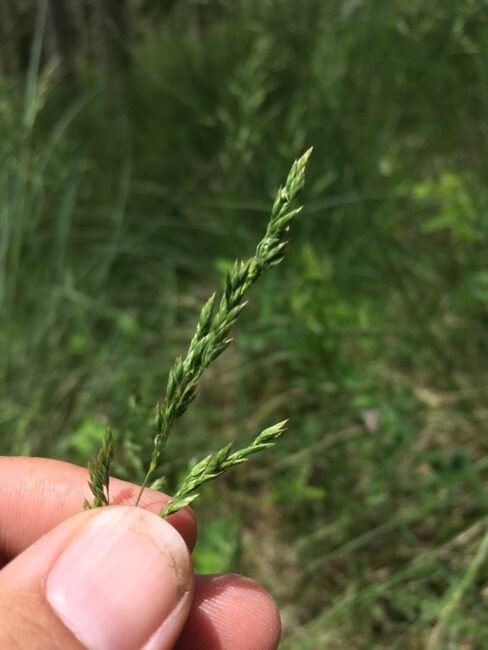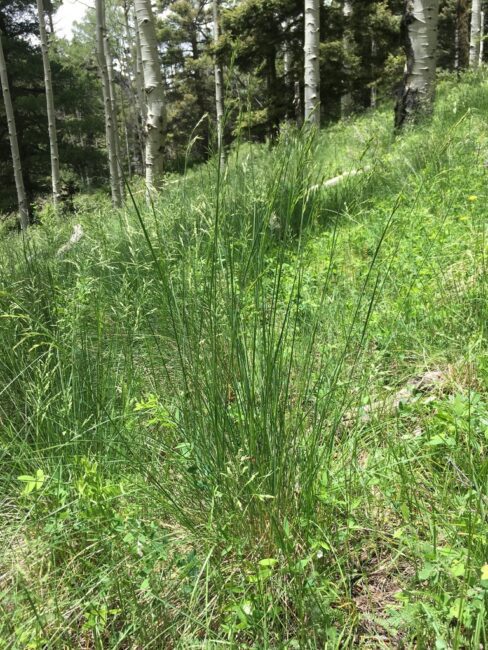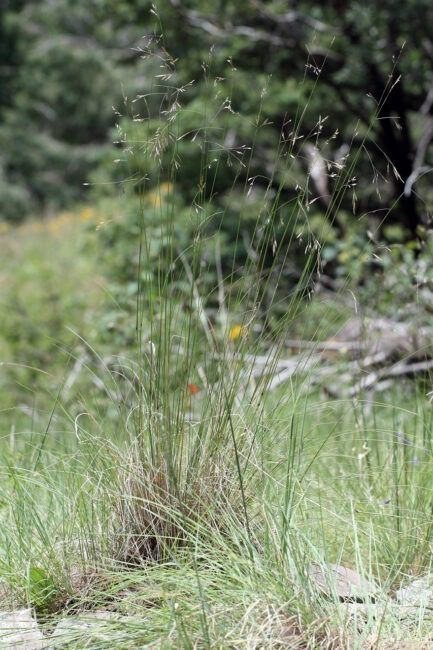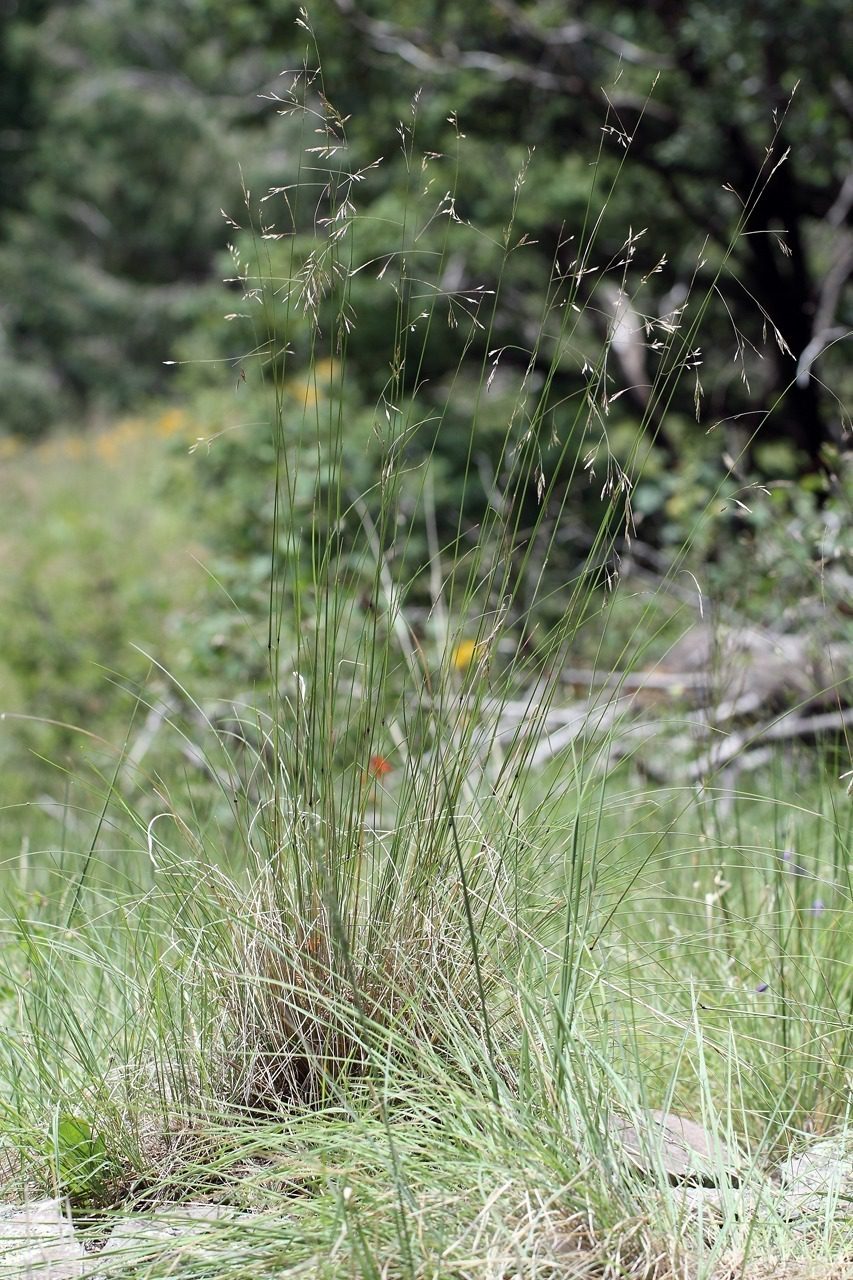Festuca thurberi, commonly known as Thurber’s fescue, is a type of grass native to North America, specifically found in the western United States and parts of Mexico.
This grass species is named after the American botanist George Thurber, who was known for his contributions to the study of Southwestern plant species.
Thurber’s fescue is a cool-season perennial grass that typically grows in open woodlands, meadows, and mountainous regions. It is a bunchgrass, meaning it forms dense clumps of grass rather than spreading through underground rhizomes. The grass can reach heights of up to 2 feet (60 cm) and features narrow, finely textured leaves.
Thurber’s fescue has slender, fine-textured leaves that are typically green, with a bunching growth habit. The leaves are typically 2-6 mm wide and can vary in length.
The grass produces seed heads with small, densely packed spikelets, which contain the grass’s seeds. These seed heads are typically purplish or brownish in color.
This grass species plays a vital role in its native ecosystems, providing forage for wildlife and livestock. It can also help with soil erosion control due to its bunching growth habit and extensive root system.
Festuca thurberi is well-suited to a range of environmental conditions, including various soil types and elevations. It is often found in mountainous regions and foothills, but it can also thrive in other habitats.
Thurber’s fescue is sometimes used in landscaping and ecological restoration projects, particularly in regions with similar environmental conditions to its natural habitat.
Additionally, it is important to note that Thurber’s fescue may not be as well-known or widely cultivated as some other grass species, but it plays an important role in the ecosystems where it is native.
Its adaptation to a range of conditions makes it a valuable component of various ecosystems and a potential resource for sustainable land management and restoration efforts.
Read Also: 17 Medicinal Health Benefits Of Plantago media (Hoary Plantain)
How To Grow Thurber’s Fescue (Festuca Thurberi)

Growing Thurber’s fescue (Festuca thurberi) can be a rewarding endeavor, whether you’re a homeowner looking to enhance your landscape or an agriculturist interested in sustainable forage or erosion control.
This cool-season grass native to western North America requires careful attention to certain key factors to ensure its successful growth.
Here’s a detailed guide on how to grow Thurber’s fescue grass;
1. Selecting the Right Location: Thurber’s fescue thrives in open woodlands, meadows, and mountainous regions, so choose a location that replicates these conditions as closely as possible. It prefers well-drained soils with good aeration.
2. Soil Preparation: Prepare the soil by testing its pH and nutrient levels. Ideally, the pH should be slightly acidic to neutral (around 6.0-7.0). If necessary, amend the soil to achieve these levels. Ensure proper soil drainage to prevent waterlogging, which can be detrimental to Thurber’s fescue.
3. Planting: You can establish Thurber’s fescue from seeds or as nursery-grown transplants. Fall is the best time for seeding, as the cool temperatures and moisture promote germination and early growth.
For seeding, distribute the seeds evenly over the prepared soil. Cover them with a thin layer of soil, around 1/4 to 1/2 inch deep. If using transplants, dig holes slightly larger than the root ball and space them appropriately, following the recommendations on the plant labels.
4. Watering: Keep the soil consistently moist during the germination and establishment phase, which may take a few weeks. Once the grass is established, Thurber’s fescue is relatively drought-tolerant.
5. Fertilization: Thurber’s fescue is not a heavy feeder. Apply a balanced, slow-release fertilizer in early spring to provide essential nutrients. Be cautious not to over-fertilize, as this can lead to excessive growth and potential thatch buildup.
6. Maintenance: Regularly monitor the grass for pests and diseases. Treat as necessary to prevent damage. Mow the grass when it reaches a height of around 3 inches.
Keep it between 2 to 4 inches in height to maintain a healthy stand. Avoid mowing too closely, as it can stress the grass and make it susceptible to drought and weed competition.
7. Erosion Control: If using Thurber’s fescue for erosion control, consider planting in a grid pattern to maximize coverage and minimize soil erosion risks.
8. Wildlife and Livestock: Keep in mind that Thurber’s fescue provides forage for wildlife and livestock. It can be a valuable resource for grazing, so plan your management accordingly.
9. Monitoring and Adaptation: Regularly assess the health and vigor of your Thurber’s fescue stand. If it appears to be thinning or struggling, consider overseeding or making adjustments to your management practices.
10. Pest and Disease Management: Keep an eye out for common pests such as grasshoppers and aphids, as well as fungal diseases like rust or leaf spot. Employ integrated pest management practices and use appropriate treatments if infestations occur.
11. Thinning and Rejuvenation: Over time, Thurber’s fescue stands may become overcrowded, leading to decreased vigor. Consider thinning the grass by hand or mechanical means to allow for better air circulation and sunlight penetration.
12. Weed Control: Weeds can compete with Thurber’s fescue for resources. Regularly inspect the area for weeds and take appropriate measures, such as hand weeding or targeted herbicide application, to control their growth.
13. Companion Planting: Consider companion planting with native wildflowers or other grass species that complement Thurber’s fescue. This can enhance the overall biodiversity and aesthetic appeal of your landscape.
14. Environmental Considerations: Being a native grass, Thurber’s fescue plays a crucial role in its ecosystem. Promote environmental stewardship by conserving this species and avoiding its displacement by invasive grasses.
15. Seed Harvesting: If you want to collect seeds for propagation or restoration projects, let the grass mature and produce seed heads. Harvest the seeds once they have turned brown or matured. Properly store the seeds in a cool, dry place for future use.
16. Seasonal Care: Thurber’s fescue is a cool-season grass, so it tends to be most active in the spring and fall. Adjust your management practices, such as watering and mowing, to the seasonal requirements of the grass.
17. Local Regulations and Conservation Efforts: Be aware of local regulations and conservation efforts regarding the use and management of native plant species. Compliance with these regulations can help protect the natural habitat and biodiversity of Thurber’s fescue.
How To Care For Thurber’s Fescue Grass (Festuca Thurberi)

Caring for Thurber’s fescue (Festuca thurberi) is essential to ensure its health, resilience, and longevity in your landscape or agricultural setting. This native grass offers numerous benefits, from erosion control to wildlife habitat, and proper care will help you make the most of its potential.
Here’s a comprehensive guide on how to care for Thurber’s fescue grass;
1. Watering: Thurber’s fescue is relatively drought-tolerant once established. Water it sparingly during dry periods, providing approximately 1 inch of water per week. Avoid overwatering, as this can lead to shallow root growth and reduced drought resistance.
2. Mowing: Maintain your Thurber’s fescue at a height of 2 to 4 inches. Mowing at this height encourages a dense and healthy stand. Never remove more than one-third of the grass’s height in a single mowing session.
3. Fertilization: Thurber’s fescue doesn’t require heavy fertilization. Apply a balanced, slow-release fertilizer in early spring, following the manufacturer’s recommendations. Over-fertilization can lead to excessive growth and thatch accumulation.
4. Pest and Disease Management: Regularly inspect your grass for common pests like grasshoppers or aphids and signs of fungal diseases such as rust or leaf spot. Implement integrated pest management practices, including natural predators and targeted treatments if necessary.
5. Thinning and Rejuvenation: Over time, Thurber’s fescue stands may become overcrowded, leading to decreased vigor. Thin the grass by removing older, weaker plants to improve air circulation and sunlight penetration.
6. Weed Control: Keep an eye out for weeds competing with Thurber’s fescue. Address weeds promptly through manual removal or selective herbicide application. A weed-free environment helps the grass thrive.
7. Companion Planting: Consider companion planting with native wildflowers or other grass species that complement Thurber’s fescue. This can enhance the overall biodiversity and aesthetic appeal of your landscape.
8. Seasonal Care: Thurber’s fescue is most active during the spring and fall. Adjust your maintenance practices, such as mowing and fertilization, according to the grass’s seasonal requirements.
9. Environmental Considerations: As a native grass species, Thurber’s fescue contributes to the local ecosystem. Maintain good environmental stewardship by conserving this grass and protecting it from displacement by invasive species.
10. Local Regulations and Conservation Efforts: Be aware of local regulations and conservation efforts related to the management of native plant species. Comply with these regulations to support the preservation of natural habitats and biodiversity.
11. Seed Harvesting: If you intend to collect seeds for future propagation or restoration projects, allow the grass to mature and produce seed heads. Harvest the seeds when they turn brown or mature, and store them properly in a cool, dry place.
12. Wildlife and Livestock: Thurber’s fescue provides valuable forage for wildlife and livestock. If you’re using this grass for grazing, practice responsible management to maintain a balanced ecosystem.
By following these care guidelines, you can nurture a thriving stand of Thurber’s fescue. This native grass offers numerous environmental and practical benefits, making it a valuable addition to your landscape or agricultural ventures. Your dedication to its well-being will ensure its continued success and ecological contributions.
Read Also: Definition, Advantages, and Disadvantages of Grazing Management System
The Uses and Benefits of Thurber’s Fescue (Festuca Thurberi)

Thurber’s fescue (Festuca thurberi) is a grass with several uses and benefits in agriculture, landscaping, and ecological restoration. Understanding these applications can help you appreciate the value of this versatile grass species.
Here’s a detailed exploration of the uses and benefits of Thurber’s fescue grass;
1. Erosion Control: Thurber’s fescue is an excellent choice for erosion control on slopes, hillsides, and disturbed areas. Its extensive root system helps stabilize soil, reducing the risk of erosion caused by wind and water.
2. Wildlife Habitat: Thurber’s fescue provides essential habitat and forage for wildlife, including deer, elk, and various bird species. The grass’s dense growth and seeds serve as a valuable food source and protective cover.
3. Livestock Forage: For agricultural purposes, Thurber’s fescue offers nutritious forage for livestock, such as cattle and sheep. It can be grazed, contributing to sustainable livestock management.
4. Native Plant Restoration: Thurber’s fescue plays a crucial role in the restoration of native plant communities. When used in habitat restoration projects, it helps recreate the natural ecosystem, benefiting native flora and fauna.
5. Soil Improvement: The deep, fibrous root system of Thurber’s fescue enhances soil structure by increasing organic matter content and improving soil aeration and water infiltration. This contributes to overall soil health.
6. Aesthetic Landscaping: In landscaping, Thurber’s fescue is valued for its fine-textured, ornamental appearance. It adds a natural, native charm to gardens and naturalized areas.
7. Drought Tolerance: Once established, Thurber’s fescue exhibits good drought tolerance, making it a suitable choice for regions with sporadic or limited water availability.
8. Biodiversity Support: Thurber’s fescue aids in preserving biodiversity by providing a home and sustenance for various native species. It contributes to the overall health and balance of ecosystems.
9. Carbon Sequestration: Like many grasses, Thurber’s fescue can capture and store carbon dioxide from the atmosphere in its roots and plant material, contributing to carbon sequestration efforts.
10. Low Maintenance: This grass species is relatively low maintenance, requiring less water and fertilizer compared to some non-native alternatives. Its adaptability to various soil types and conditions reduces the need for extensive care.
11. Weed Suppression: Thurber’s fescue can help suppress the growth of invasive weeds when managed properly, contributing to the overall health of the ecosystem.
12. Soil Erosion Mitigation: In addition to preventing erosion, Thurber’s fescue also reduces sedimentation in nearby water bodies, helping to maintain water quality.
13. Education and Research: This native grass serves as an important subject of study for researchers and educators, offering insights into plant ecology, conservation, and land management practices.
In conclusion, Thurber’s fescue is a versatile native grass that provides a range of uses and benefits, from its ecological significance in wildlife habitat and ecosystem restoration to its practical applications in agriculture, landscaping, and sustainable land management.
Understanding and harnessing these benefits can lead to more resilient and biodiverse ecosystems while addressing various agricultural and environmental challenges.
Frequently Asked Questions on Thurber’s Fescue (Festuca Thurberi)
Here’s an informative list of some of the frequently asked questions (FAQs) about Thurber’s fescue (Festuca thurberi) to help you better understand this native grass species:
1. What is Thurber’s fescue, and where is it native to? Thurber’s fescue, scientifically known as Festuca thurberi, is a cool-season grass native to western North America. It is found in regions of the United States, primarily in the western states and parts of Mexico.
2. What are the key characteristics of Thurber’s fescue? Thurber’s fescue is a bunchgrass with fine-textured leaves. It typically reaches heights of up to 2 feet and features seed heads with small, densely packed spikelets, usually purplish or brownish in color.
3. What are the primary ecological roles of Thurber’s fescue? Thurber’s fescue serves as forage for wildlife and livestock. Additionally, it plays a crucial role in soil erosion control, thanks to its bunching growth habit and extensive root system.
4. Can Thurber’s fescue be used in landscaping projects? Yes, Thurber’s fescue can be used in landscaping, particularly in regions with environmental conditions similar to its native habitat. It adds an aesthetic appeal to naturalized landscapes.
5. How do I grow Thurber’s fescue from seeds? To grow Thurber’s fescue from seeds, sow them in the fall, distributing them evenly over prepared soil. Cover the seeds with a thin layer of soil, about 1/4 to 1/2 inch deep. Keep the soil consistently moist until the grass is established.
6. Is Thurber’s fescue suitable for grazing by livestock? Yes, Thurber’s fescue can be suitable for grazing by livestock, providing a source of forage. However, responsible grazing management is essential to maintain a balanced ecosystem and prevent overgrazing.
7. When is the best time to fertilize Thurber’s fescue? Fertilize Thurber’s fescue in early spring with a balanced, slow-release fertilizer. Be cautious not to over-fertilize, as this can lead to excessive growth and thatch accumulation.
8. What is the recommended mowing height for Thurber’s fescue? Maintain Thurber’s fescue at a mowing height of 2 to 4 inches. Avoid cutting more than one-third of the grass’s height in a single mowing session to promote a healthy stand.
9. Are there any common pests or diseases that affect Thurber’s fescue? Thurber’s fescue may be susceptible to pests like grasshoppers and aphids. Additionally, it can experience fungal diseases such as rust or leaf spot. Regular monitoring and prompt treatment can help manage these issues.
10. Can Thurber’s fescue be used for erosion control? Yes, Thurber’s fescue is often used for erosion control due to its bunching growth habit and robust root system. It helps stabilize soil in areas prone to erosion.
11. How can I promote environmental stewardship when growing Thurber’s fescue? To promote environmental stewardship, conserve Thurber’s fescue in its natural habitat and avoid displacing it with invasive species. Comply with local regulations and conservation efforts related to native plant species.
12. Can I collect Thurber’s fescue seeds for future use or restoration projects? Yes, you can collect Thurber’s fescue seeds when they mature and turn brown. Properly store the seeds in a cool, dry place for use in future propagation or restoration projects.
Read Also: 10 Reasons Why Food Workers Should Keep Garbage Cans Clean and Free of Buildup






